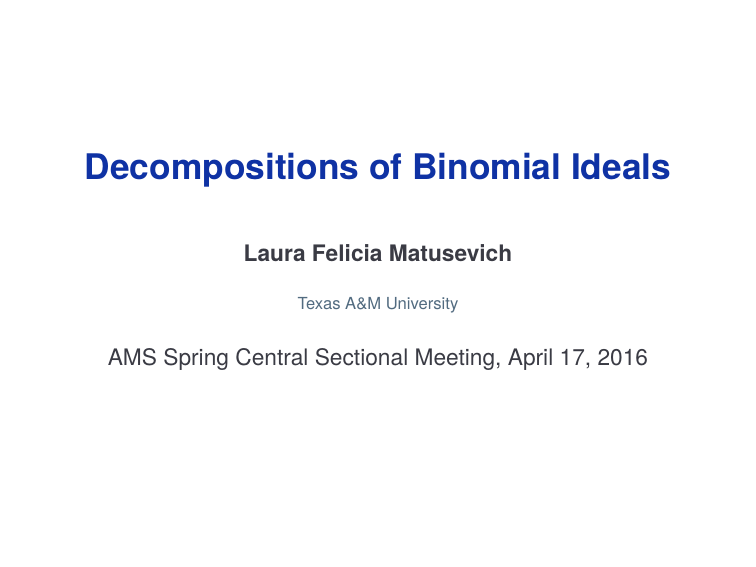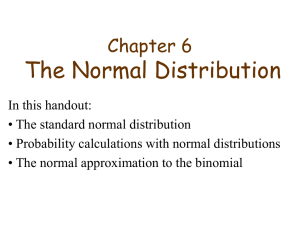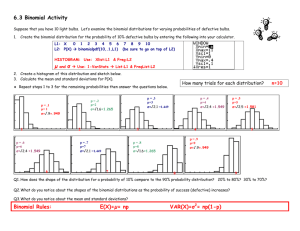Decompositions of Binomial Ideals Laura Felicia Matusevich Texas A&M University
advertisement

Decompositions of Binomial Ideals Laura Felicia Matusevich Texas A&M University AMS Spring Central Sectional Meeting, April 17, 2016 Polynomial Ideals R = k[x1 ; : : : ; xn ] the polynomial ring over a field k. A monomial is a polynomial with one term, a binomial is a polynomial with at most two terms. Monomial ideals are generated by monomials, binomial ideals are generated by binomials. Monomial ideals: Algebra, Combinatorics, Topology. Toric Ideals: Prime binomial ideals. Algebra, Combinatorics, Geometry. Binomial Ideals Theorem (Eisenbud and Sturmfels, 1994) I R a binomial ideal, k algebraically closed. I Geometric Statement: Var(I ) is a union of toric varieties. I Algebraic Statement: The associated primes and primary components of I can be chosen binomial. Why are Noetherian rings called Noetherian? R commutative ring with 1, Noetherian (ascending chains of ideals stabilize). A proper ideal I I is primary if xy R is prime if xy 2 I implies x 2 I or y 2 I . 2 I and xn 2= I 8n 2 N, implies y 2 I . Theorem (Lasker 1905 (special cases), Noether 1921) Every proper ideal I ( R has a decomposition as a finite intersection of primary ideals. The radicals of the primary ideals appearing in the decomposition are the associated primes of I . Binomial Ideals Theorem (Eisenbud and Sturmfels, 1994) I R a binomial ideal, k algebraically closed. I Geometric Statement: Var(I ) is a union of toric varieties. I Algebraic Statement: The associated primes and primary components of I can be chosen binomial. I Combinatorial Statement: The subject of this talk. Need k algebraically closed; char(k) makes a difference. Example: In k[y ], consider I = hy p 1i. No hope of nice combinatorics for trinomial ideals. There is combinatorics! (Slide of joy) I h x2 = hx = y 3 ; x3 1; y 1 y4i i \ (I + hx4; x3y; x2y2; xy4; y5i) Works for binomial ideals over k = k with char(k) = 0. But how to make sure we have all bounded components? There is combinatorics! (Slide of joy) I h x2 = hx = y 3 ; x3 1; y 1 y4i i \ (I + hx4; x3y; x2y2; xy4; y5i) Works for binomial ideals over k = k with char(k) = 0. But how to make sure we have all bounded components? There is combinatorics! (Slide of joy) I h x2 = hx = y 3 ; x3 1; y 1 y4i i \ (I + hx4; x3y; x2y2; xy4; y5i) Works for binomial ideals over k = k with char(k) = 0. But how to make sure we have all bounded components? There is combinatorics! (Slide of joy) I h x2 = hx = y 3 ; x3 1; y 1 y4i i \ (I + hx4; x3y; x2y2; xy4; y5i) Works for binomial ideals over k = k with char(k) = 0. But how to make sure we have all bounded components? There is combinatorics! (Slide of joy) I h x2 = hx = y 3 ; x3 1; y 1 y4i i \ (I + hx4; x3y; x2y2; xy4; y5i) Works for binomial ideals over k = k with char(k) = 0. But how to make sure we have all bounded components? There is combinatorics! (Slide of joy) I h x2 = hx = y 3 ; x3 1; y 1 y4i i \ (I + hx4; x3y; x2y2; xy4; y5i) Works for binomial ideals over k = k with char(k) = 0. But how to make sure we have all bounded components? There is combinatorics! (Slide of joy) I h x2 = hx = y 3 ; x3 1; y 1 y4i i \ (I + hx4; x3y; x2y2; xy4; y5i) Works for binomial ideals over k = k with char(k) = 0. But how to make sure we have all bounded components? There is combinatorics! (Slide of joy) I h x2 = hx = y 3 ; x3 1; y 1 y4i i \ (I + hx4; x3y; x2y2; xy4; y5i) Works for binomial ideals over k = k with char(k) = 0. But how to make sure we have all bounded components? Switch gears: Lattice Ideals If L Zn is a lattice, and : L ! k is a group homomorphism, I () = hxu (u v )xv j u; v 2 Nn ; u v 2 Li k[x1; : : : ; xn] is a lattice ideal. Theorem (Eisenbud–Sturmfels) A binomial ideal I is a lattice ideal iff mb 2 I for m monomial, b binomial ) b 2 I . If k is algebraically closed, the primary decomposition of I () can be explicitly determined in terms of extensions of to Sat(L) = (Q Z L) \ Zn . Lattice Ideals are easy to decompose Example L = spanZ f( : Z4 1; 0; 3; 2); (2; f I () = hxw2 If char(k) 6= 3, then I = g Z4. ! k the trivial character. Sat(L) = spanZ (1; Ij 3; 0; 1) hyz z 3 ; x2 w 2; 1; 0); (0; 1; = ! j xw; xz 2; 1) g y 3 i: and I1 \ I2 \ I3 , where !j y2; z2 If char(k) = 3, I is primary. ! 2j ywi; !3 jSat(L)=Lj = 3 = 1; ! 6= 1: What next The good: Relevant combinatorics: monoid congruences. Laura, don’t forget to explain what congruences are. The not so good: Field assumptions, computability issues. Take a deep breath: Stop decomposing at the level of lattice ideals. The choices: I Finest possible ! Mesoprimary Decomposition [Kahle-Miller] I Coarsest possible ! Unmixed Decomposition [Eisenbud-Sturmfels], [Ojeda-Piedra], [Eser-M] Too many definitions Colon ideal and saturation: (I : x) = ff j xf 2 I g and (I : x1 ) = ff j 9` > 0; x`f 2 I g I binomial ideal, m monomial ) (I : m); (I : m1 ) binomial. Let f1; : : : ; ng. I k[x1 ; : : : ; xn ] is -cellular if 8i 2 , ` (I : xi ) = I , and 8j 2 = , 9`j > 0 such that xjj 2 I . I a -cellular binomial ideal. I I is mesoprime if I = hIlat i + hxj j j 2 = i for some lattice ideal Ilat = Ilat k[xi j i 2 ]. I I is mesoprimary if b 2 k[xi j i 2 ] binomial, m monomial and bm 2 I ) m 2 I or b 2 Ilat = I \ k[xi j i 2 ]. I I is unmixed if Ass(I ) = Ass(hIlat i + hxj j xj 2 = i), where Ilat = I \ k[xi j xi 2 ]. Cellular, Mesoprimary, Unmixed I a -cellular binomial ideal, mesoprime. I I is mesoprime if I = hIlat i + hxj j j 2 = i for some lattice ideal Ilat k[xi j i 2 ]. I I is mesoprimary if b 2 k[xi j i 2 ] binomial, m monomial and bm 2 I ) m 2 I or b 2 Ilat = I \ k[xi j i 2 ]. I I is unmixed if Ass(I ) = Ass(hIlat i + hxj j xj 2 = i), where Ilat = I \ k[xi j xi 2 ]. Example I = hx3 1; y (x 1); y 2i cellular, unmixed, not mesoprimary, with decomposition I = hx3 1; y i \ hx 1; y 2 i: If char(k) = 3, I is primary. If char(k) 6= 3, the primary decomposition is I = hx !; y i \ hx ! 2 ; y i \ hx 1; y 2 i; ! 3 = 1; ! 6= 1. Cellular, Mesoprimary, Unmixed I a -cellular binomial ideal, mesoprime. I I is mesoprime if I = hIlat i + hxj j j 2 = i for some lattice ideal Ilat k[xi j i 2 ]. I I is mesoprimary if b 2 k[xi j i 2 ] binomial, m monomial and bm 2 I ) m 2 I or b 2 Ilat = I \ k[xi j i 2 ]. I I is unmixed if Ass(I ) = Ass(hIlat i + hxj j xj 2 = i), where Ilat = I \ k[xi j xi 2 ]. Example I = hIlat i + hIart i is always mesoprimary but converse is not true. For instance hx2y2 is mesoprimary. 1; xz yw; z 2 ; w2 i At last Theorem Decompositions of binomial ideals into I mesoprimary binomial ideals [Kahle-Miller] I unmixed cellular binomial ideals [Eisenbud-Sturmfels] [Ojeda-Piedra] [Eser-M] exist over any field. The punchline: Now primary decomposition is easy! But how to do it? (Handwavy slide, we are all tired) The easy case: I is -cellular. For m monomial in k[xj j j 2 = ], Jm lattice ideal. = (I : m) \ k[xi j i 2 ] is a The unmixed/mesoprimary components of I are of the form (I + Jm ) : Y i2 x1 i + "combinatorial" monomial ideal Mesoprimary decomposition: largest possible monomial ideal. Unmixed decomposition: smallest possible monomial ideal. It is easy to produce mesoprimary/unmixed decompositions. Controlling the decompositions is hard. Slide of shame Binomial ideals do not in general have irreducible binomial decompositions [Kahle-Miller-O’Neill]. I a binomial ideal. I When is k[x]=I Cohen–Macaulay? I Gorenstein? I What are the Betti numbers of k[x]=I ? I Can a (minimal) free resolution be constructed? I Is there something like the Ishida complex? I Ask any interesting question here... I do not know. The optimistic ending: An emerging area, with lots of interesting open problems! THANK YOU! Proof of Noether’s theorem (slide of the second wind) I ( R is reducible if I = J1 \ J2 with J1 ; J2 ) I . 1. Every proper ideal has an irreducible decomposition. If I does not have an irreducible decomposition, can produce a non-stabilizing ascending chain of ideals. 2. Irreducible ideals are primary. I is primary iff every x 2 R is either nilpotent or a nonzerodivisor modulo I . Suppose x 2 R is neither nilpotent nor a nonzerodivisor mod I . Then: (I : x) (I : x2 ) (I : x3 ) so 9N : (I : xN ) = (I : xN +1 ) = Claim. I = I + hxN i \ I : xN








